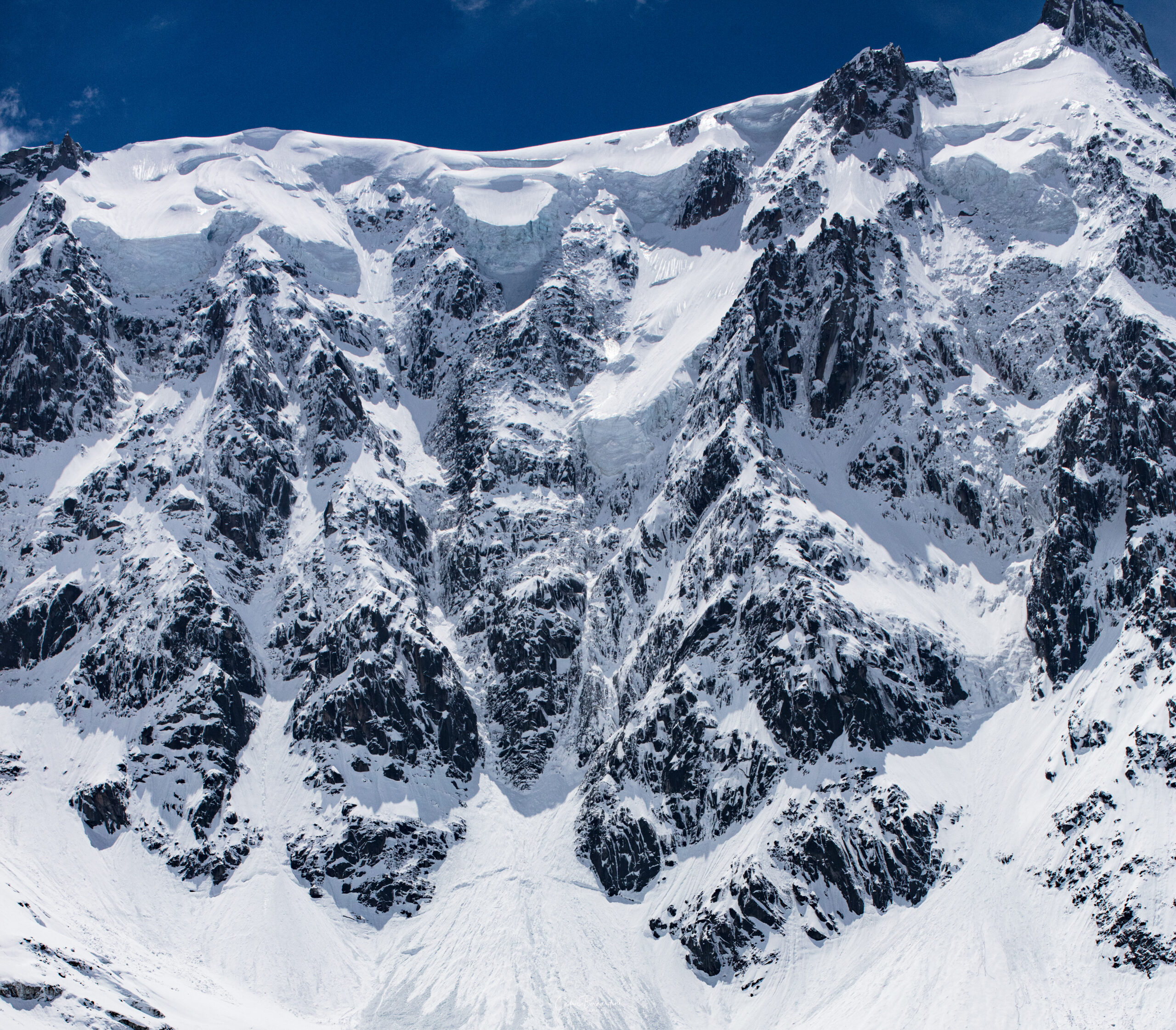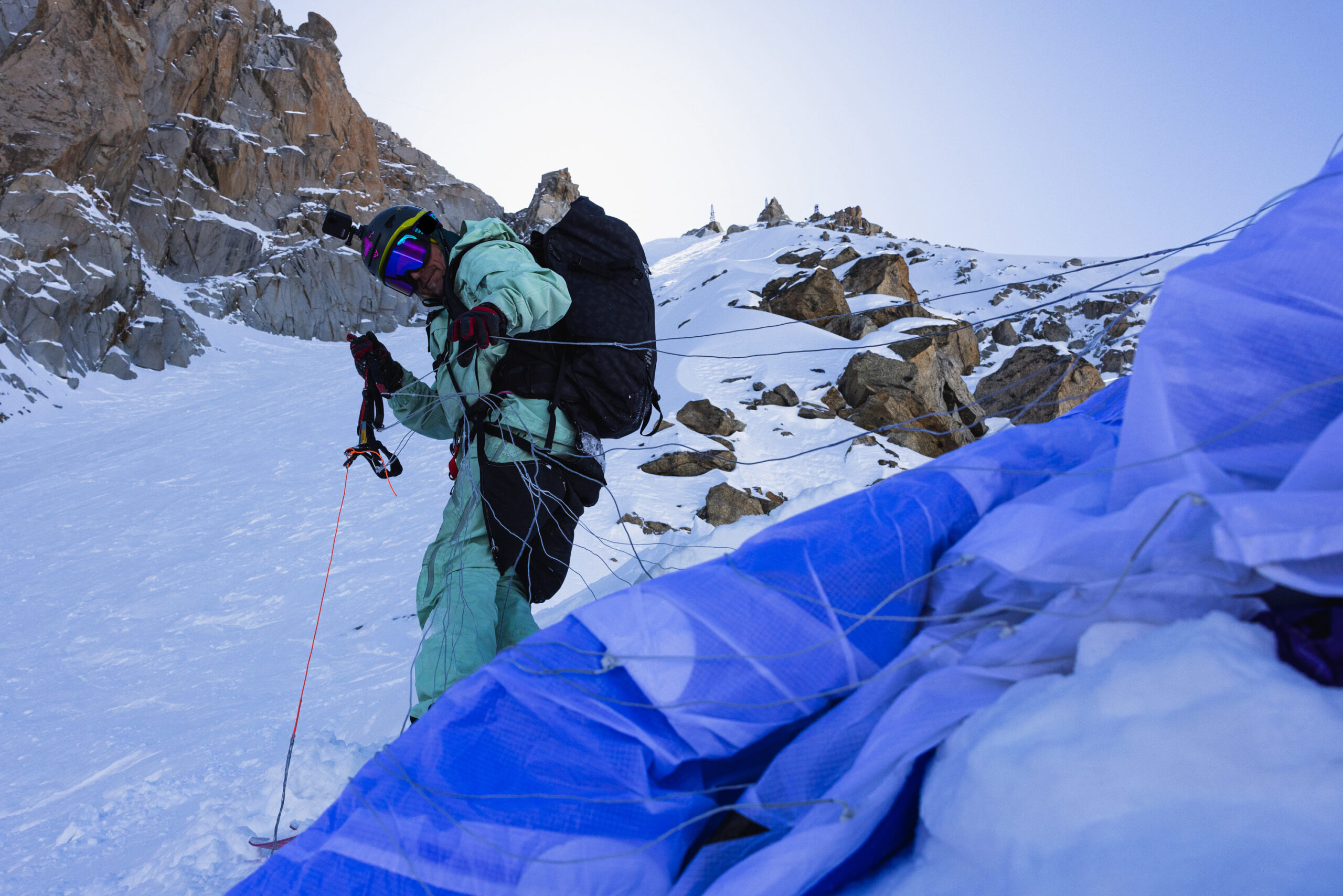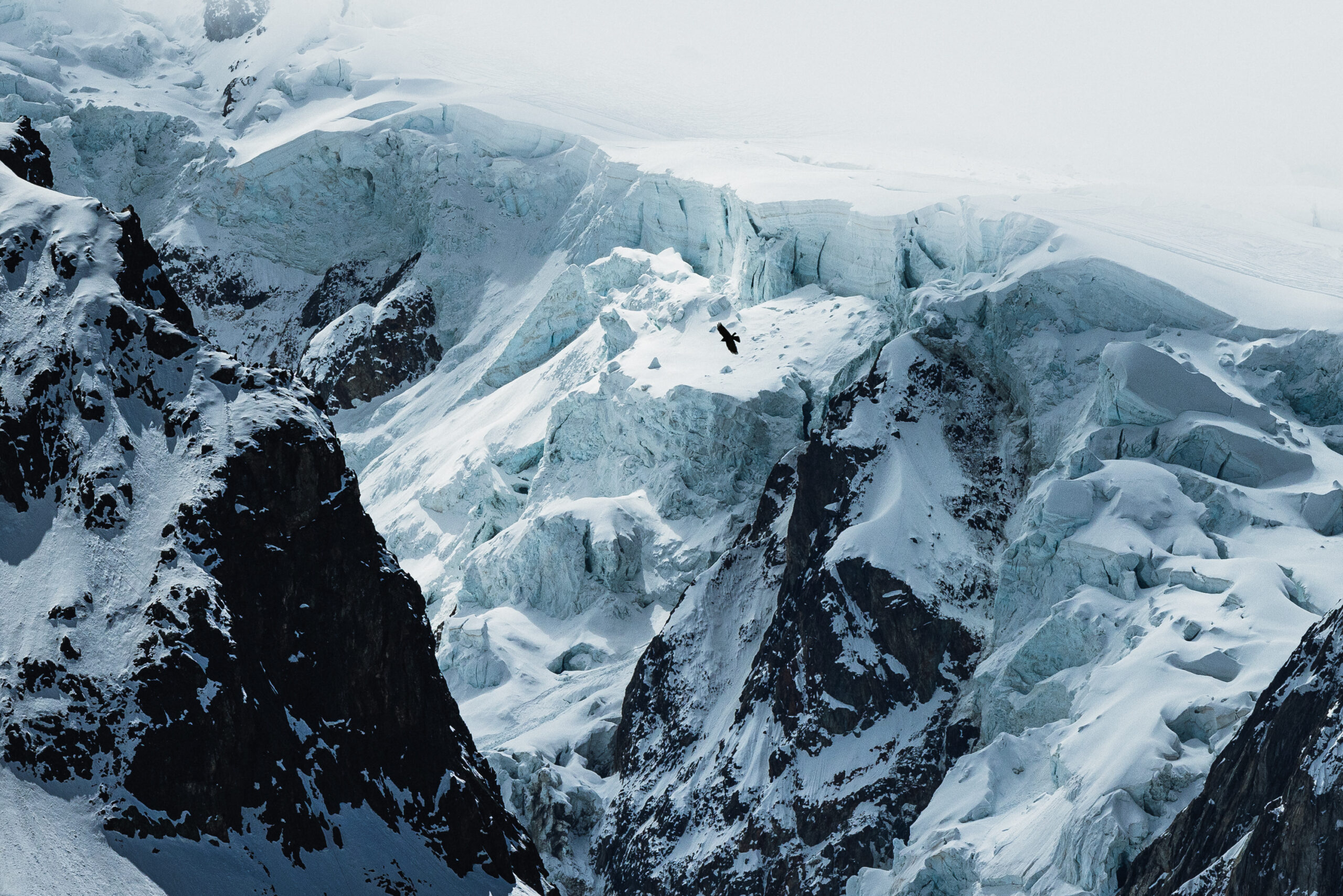Kawaptain’s log, star date 2013.6.
His mission : to embark on skiing’s frontier, using a secret weapon of nylon and strings in an attempt to ski the face and fly off the end.
The Mother Ship’s arms were open.
The North Face, cleared for take-off.
It was a deep blue day. The sun was at its zenith. Only the comings and goings of the cable car disturbed the immense north face of the aiguille du Midi. Inside one of them, a cabin operator was easing his boredom by watching the climbers and steep skiers along the north face. A trace caught his eye above the huge serac that marks the 1,000-meter wall below the summit ridge. Symmetrical turns suddenly disappeared into the void. Someone had taken the plunge. He sounded the alarm. Several observers tried to locate the body with binoculars, but the human remains were nowhere to be found. In reality, they were much lower and still very much alive. He had long blond hair bound in a colorful headband and was drinking a beer while admiring his work.

Bird under the watch full eye of the mother ship. Photo by @mathew_tufts
Michael Anthony “Bird” Shaffer, a US ski bum from the North Cascades, Washington State, had just realized his vision. Skiing the beautiful powder of the North Face, then, instead of zigzagging between the rocks and rappelling several times to find the exit, had stopped above the abyss, taken a small parachute out of his backpack, unfurled it and flown away.
Speed riding combines a mini wing with a pair of skis. The original principle is to be able to ski while flying. The glider does not fly like a paraglider, but is designed to fall. You can regain a few feet of altitude to follow the terrain, but it’s not big enough to take on updrafts. Most speed riders use the wing to stay between the air and the ground. The aim is to touch the snow, make turns and then take off again. Using a speed glider is also called speed flying if you use it without skis and foot launch.
Bird wasn’t originally interested in speed-riding. Being a skier at heart, what he saw, as Antoine Montant had done a few years earlier (1981-2011. Paragliding champion and forerunner of speed-riding, Editor’s note), was being able to ski any face, then take off to get out of it. The prospect of combining skiing and flying lent itself perfectly to Bird’s character, and he threw himself into it body and soul, participating in its blossoming, particularly among the younger generation.
Unlike base skiing, which requires careful spotting for take-off and a parachute ready to open in the back, speed riding is flexible. All you need to do is carry your glider in your bag, find a relatively sheltered spot to set up, and take off. However, ski-base advocates will argue that in ski-base, you don’t need to stop to cook and gear up. Basically, the two activities are different and incomparable. On the other hand, each is not without risk. Bird has had his share of accidents. Today, the man who has been a Black Crows ambassador since the brand’s origins, looks back on this activity, which he sees as an essential evolution of mountain skiing. And to paraphrase Captain Kirk of the Star Trek series, “you can’t avoid the future”.

Bird skiing and flying, the soul of speed-riding. Photo by @mathew_tufts
What was your first encounter with speedride and what was your reaction?
From the moment I saw two alien-like creatures, flying like hovercrafts just off the snow at the Grands Montets in the early days. I believe one of them was Antoine Montant. I knew this was for me. Though, at the time my focus was steep skiing, and it would be years before I realized the flying dream.I immediately thought of what could be done on skis using a wing. The obvious to me was to ski close out lines and fly from the face. Besides, one of my hero’s is Bruno Gouvy (1962-1990, editor’s note), and if he could ride the face of the Dru and then fly off with a paraglider, I figured using little wings for exiting would be relatively easy, and would open crazy possibilities.
Ski base never really entered my mind as an option, as you have to have the perfect exit and after that second of freefall it’s kinda over. With the speed glider, you could take off in any given place and play all the way down, having the option, where the snow was good, to land again and ride with wing overhead, then take off again, flying over the broken glacial ice and forests. Imagine that feeling of complete release, flying down to the beautiful grassy field full of wildflowers. The sweat dripping inside your googles lets you know that this is reality and in a few minutes time you have descended 3,000 meters to the valley floor.
Did you then try it right away and how did you start your training ?
As fate would have it, I met flier extraordinaire, Jean-Charles Blanc, late night, or should I say early morning, at Le Tof (a very special night club in the heart of Chamonix, now closed. Editor’s note). He had one of my birdwhere bracelets on, and asked if I was a flier or a penguin, and did I want to fly tandem with him the next day? That next morning, I woke in a panic, wondering where I was, and that I needed to ski, when Jean Charles walked out of his bedroom and said, “ Hey Birdy, don’t you remember you were going to fly with me today?” It just so happened it was one of those rare days, with very few others in the sky. We boosted in the thermals and flew around the Aiguilles, over the Mer De Glace, saying hello to Le Dru, finally circling back, to land downtown Chamonix 2hrs later. Maybe it was the hangover, but I was full of emotion inside, and with tears in my eyes, I looked to the sky, knowing then my life was forever changed.
I took a basic 3 day paraglide course and then, with very little coaching, started speedflying. When I look back now, I was lucky to make it through the first few years of foot launching, but on skis, just to fly, I found it mechanically quite easy. Learning to fly off the North Face of the Aiguille du Midi is not normal, but after spending intimate time up there skiing, it seemed reasonable to me. Safer in fact, with all that steep vertical, I wouldn’t hit anything. The first time I pointed off the hanging ice was an out of body experience. The whole world fell away, and I looked up at this little handkerchief-like piece of fabric with strings, and marveled at how it was holding me.

The shadow of a strange bird. Photo by @mathew_tufts
My goal was to become good enough to fly, touch and test the snow and then be able to ski the top of the classics, and at the terminus, or standard rappel places, unfurl the wing and catch big air. With lift access, it is the perfect training ground, and it became rapidly apparent to me that having a wing on my back was the ultimate tool. The first time I skied The Frendo Spur in 2013, I had flown it the day before and knew the conditions, so I could surprise my friends and make unusual big turns on the North Face. Several years later, obsessed with the vision, I would ski Frendo solo without rappel and fly off the end. A pivotal descent that had an influence on a few of the locals, who are now some of the most skilled speed riders around.

Bird flying off from the huge serac of the Frendo. Photo by @mathew_tufts
The universe provides and I was fortunate to meet my mentor and bird friend Gaby VDS, professional parapant pilot/ski instructor, who at that time was easily one of the best speed riders in the world, especially on the steeps.
With Gaby’s vision, we started to use our little speed wings, not just for descent, but as an approach tool to climb Mont Blanc. With a lift ride up the Midi, and a short traverse, we found it was possible to fly across the glacier and cut out the hazards and hours of walking through crevasse land, simplifying ascent of the highest summit in the Alps. The first time we skied off the top and then flew was a very memorable experience. The wind was strong on the top, so we made turns down chalky steep pow, and before skiing under the huge seracs we took off. I lost Gaby in the air and was left flying wild eyed, landing by the motorway in waist deep grass, feeling very alive.
So the North Face became a training ground, what was the perception of the Chamonix locals?
Anyone who has been up Mama Midi in the morning on a pow day knows how competitive the race for first tracks can be, and for me this new approach to skiing cut out the rush and anxiety. At first, my friends laughed at me struggling in the morning to get on the lift with a bigger bag. “You going camping Bird”? The reality for me, was that adding a little wing to the sac with all the necessary alpine equipment of rope, harness, crampons and ice axes, did not change the way I skied, and rapidly began expanding my choices of where, and how I would descend to the valley.

At Mama Midi, with all the right stuff. Photo by @mathew_tufts

Col du Plan, Jumeaux, Frendo, Malory. The training ground. Photo by @Michael Shaffer
Seems like yesterday, one of those crazy mornings where the North Face was full of snow, the conditions ripe for freeride. Thankfully I was with Ross Hewitt and Paul-Edouard “Papy” Millet, the first to drop in, and after coiling the rope, I ripped some 5 star pow and came screaming up to meet them at the rappel. With little to no wind, I said goodbye to my friends, who disappeared on a rope over the side. I think it was a surprise for the other teams who showed up to see me there alone preparing my wing. For me, it was an honor to share this experience of doing something bold and new with two world famous snowboarders, Jonathan Charlet and Victor de Le Rue, and renowned mountain and parapente guide Medhi Bidault, all of whom I respected and looked up to. “ Yo Bird, take care,” Medhi’s comforting words echoed in my ear, as I pointed it off the ice cliff, barrel rolling into the mystic, foggy abyss below.

Col Du Plan – blue = ski pink = bird fly. Photo by @mathew_tufts

Launching into never land. Photo by @mathew_tufts
This speed flying/ riding activity is seen as an extreme sport, therefore a very dangerous discipline. You had a few close calls yourself. What is your opinion at this stage ?
Cutting corners can be sharp, especially with speed flying. When I began there wasn’t really coaching, and being mostly self taught, I learned from my mistakes, some of which were a pretty heavy price to pay. I also have a problem with enjoying dreaming while awake, which is that flow state many of us love when powder skiing. With flying, even though it might appear less physically demanding, it’s multi dimensional with more variables and risks to consider, requiring a heightened sensitivity. In Chamonix, with lift access to the high mountains, it’s easy to go round and round, where it becomes almost normal for a Midi speed riding junkie to drop 5 to 10 runs in a day. The danger for me lies with becoming oversensitized and not staying in the present moment.
What I am hoping I’ve learned through pain and suffering is to stay present in the moment, trust my gut feeling and follow my heart. Being able to listen in the moment is a continual work in progress, so I better stay alive and keep practicing. I am already looking forward to next season.

Not a penguin for long. Michael ready to take off at the exit of Glacier Rond. Photo by @mathew_tufts
With such accidents occurring, do you think it’s something that will continue to evolve and change the way of seeing the mountains ?
It’s not about accidents, but opening up possibilities to be creative in the mountains. In many ways I think that using a wing in combo with skiing is safer.
In the last 5 years we have seen some big leaps in speed riding and using wings of all sizes in combination with skiing. Not only is glider technology improving, but there are professional ski and flying instructors, like Cyrilde Pinard in Cham, teaching speed riding. In the states there are some very good schools cropping up as well for speed flying instruction, and we are seeing some damn good pilots bringing their flying skills to Europe and then honing their speed riding skills. The evolution of our sports are happening right in front of our eyes, and it’s astonishing how quickly guys are getting dialed and what is being done on skis. The age old rule about not following a track in Cham certainly rings true as many sweet looking turns end with a straight line off to never never land, and you better have a wing yourself or you will be climbing back out.

Only in Chamonix, baby. Photo by @mathew_tufts
We are evolving in the mountains, and adapting to our surroundings. It’s like when skis got fatter and rockered, allowing us to ski steeps in pow earlier in the season. Wings are helping us adapt and have a more enjoyable time, especially with climate change, glaciers opening up, and the snow receding. Like Babs Charlet said, which I adopted wholeheartedly, “ski the best, flawk the rest!” It wouldn’t surprise me if the ski guide books will be updated soon and show where launch points are.

A good steep run under the cables… Photo by @mathew_tufts

… before take-off… Photo by @mathew_tufts
We can see you have had an influence on the new generation of skiers. How do you feel about that?
It’s kind of surreal to be a small town American boy who’s search for creative freedom has made a lasting impression on how we move in the mountains. Growing wings might have been written in the stars, as I was conceived while my dad was flying fighter planes, but it was the love and acceptance of our Chamonix Family that shared their skills, which gave way to my birdy ingenuity. I’m happy to have given a little back.
To watch the small explosion of skiers now employing wings and enjoying the ride is a delight to witness. This year it’s been something to see friends like Edgar Pascal and Papy, making speed ride pow turns in impossibly steep places. Others are shredding down classic lines, and not just linking up combos with speed gliders, but getting lofty, using paragliders to enhance the ride. All I can do is sit back and smile with a hint of jealousy, as I watch dream lines that I didn’t perceive others riding before me, go down in history. Black Crow’s ambassadors, Damien Arnaud and Ross, just skied Aiguille du Plan, sans rappel, with a beautiful paragliding exit.

Bird laying it down on a close out line off the North Face of the Tacul, while Medhi Bidault and Mathieu Vigier get ready to drop. Photo by @mathew_tufts

Lucky they have wings. Photo by @mathew_tufts

Photo by @mathew_tufts
If this is a final frontier using skis, what does the future hold?
Maybe this ski-flying thing is coming full circle. There are always new frontiers. I remember back in the day, the most radical thing to watch on skis was ski jumping. In fact, some of the oldest competitions on skis, was ski jumping, which later became ski flying. It kinda seems natural that in this day and age we would be flying in the big mountains on skis. Now, as the world has gotten smaller and powder skiing becomes more of a limited resource, it’s rewarding to see evolution happening, expanding our reality with wings. Skiing is the foundation and powder skiing will always come first, but when it’s spring you better bet I’m lining up a dream combo that hopefully includes some baguette and stinky cheese. Besides, what’s more dangerous for our children growing up today, learning to ski and fly, or waking up with a screen in their hands, disconnected with nature in this brave new AI metaverse land?! Just remember kids, flying is not really hard until you hit the ground. Keep your bird eyes open and go fullwingspan!

The speed-rider mentor, the Alpine cough. Photo by @mathew_tufts
Special thanks to the Cham Family and all the workers up Mama Midi.
Will Burks, Valentin Delluc and Ugo Gerola whose flying and speed riding skills continually inspire.
Photo Credits
Mathew Tufts’ photos were originally a part of a speed riding feature for, The Ski Journal, 17.1. https://www.theskijournal.com
Mathew Tufts -IG @mathew_tufts www.mathew-tufts.com
Jamie Petitto www.jamiepetitto.com – cosmic bird opening picture



